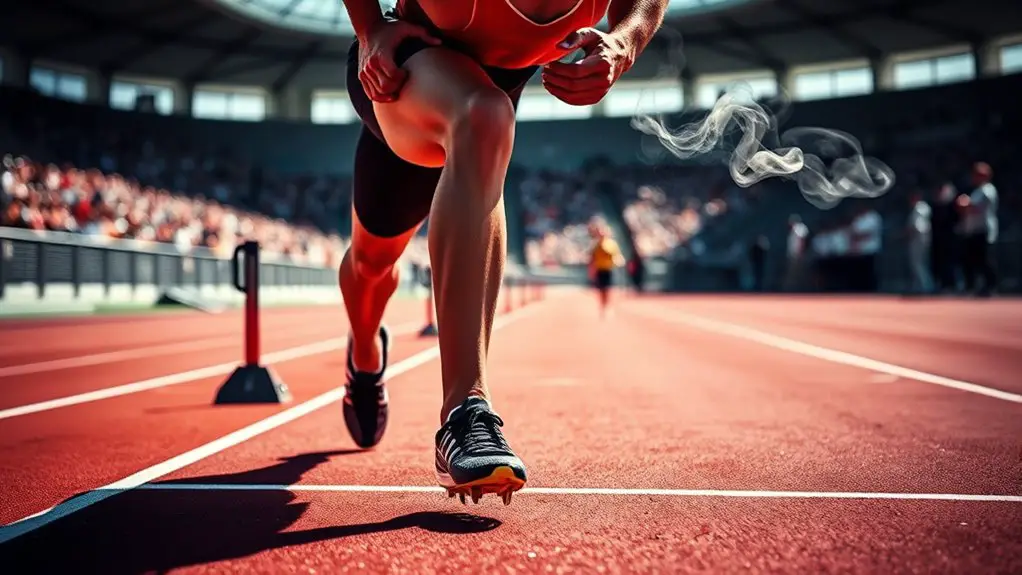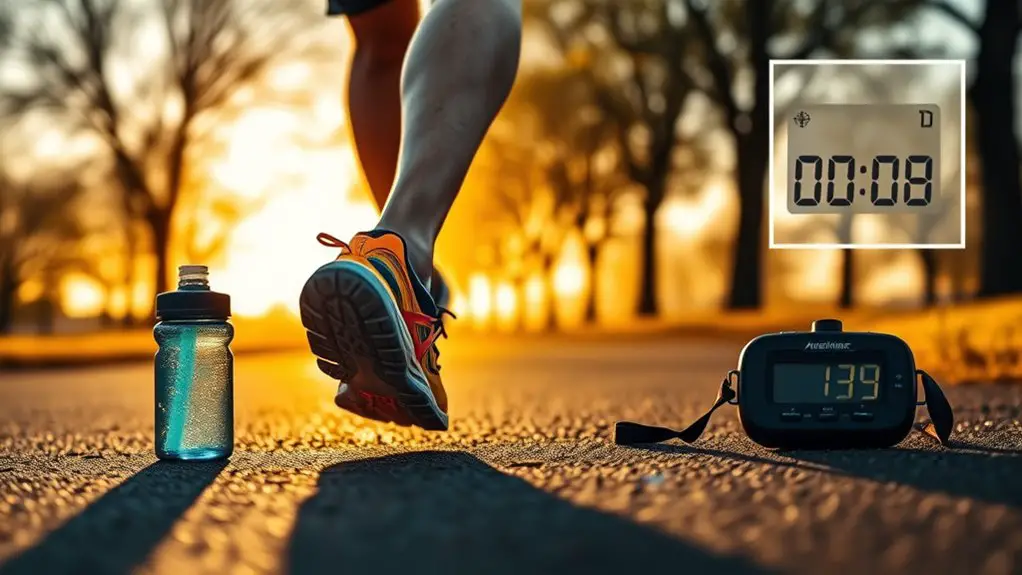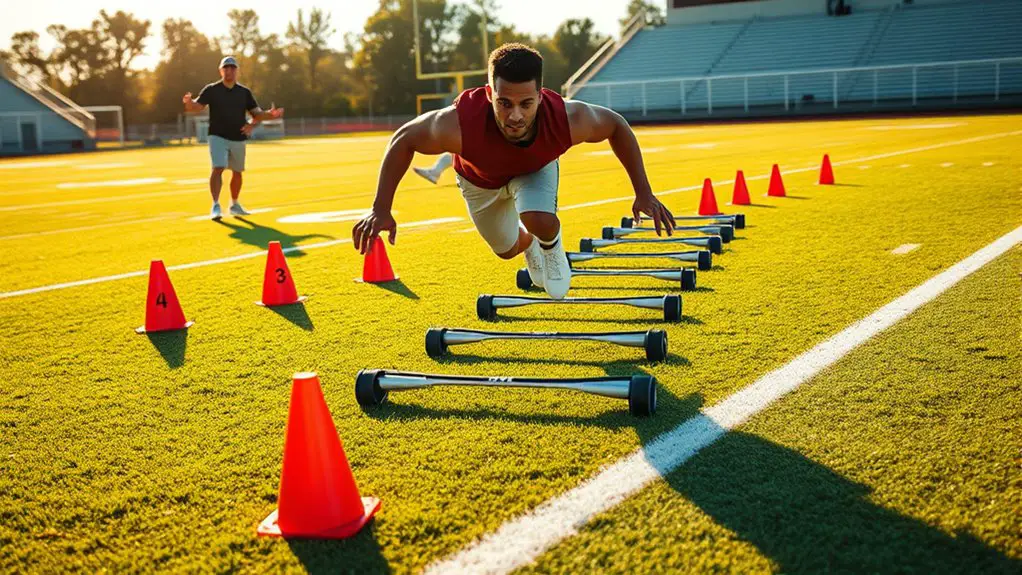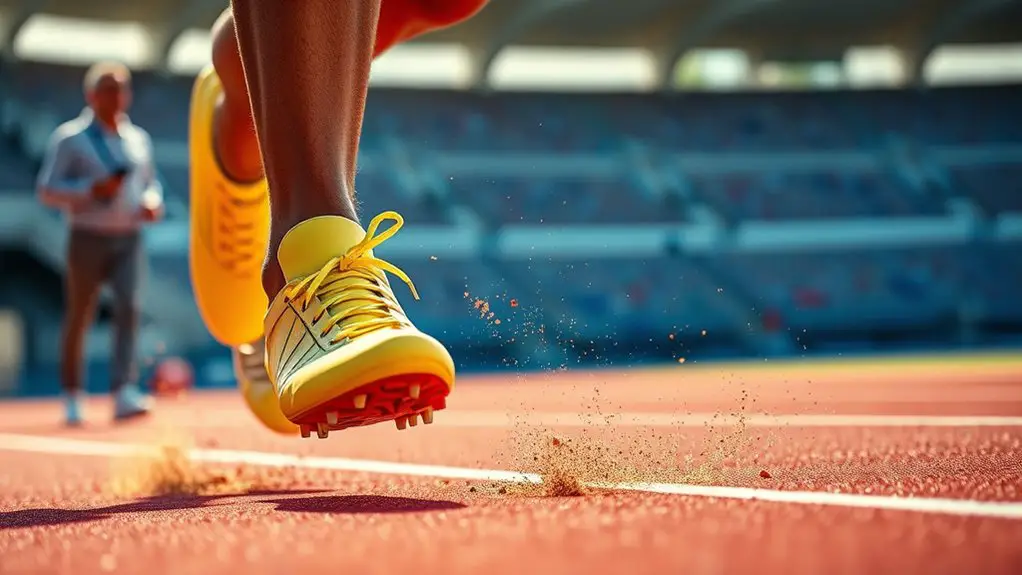To build speed for short-distance sprints, start with a proper warm-up to get your muscles ready. Focus on strength training to enhance your power, using compound exercises like squats and deadlifts. Incorporate sprint drills like high knees and butt kicks to improve your speed. Pay attention to your running form, ensuring a relaxed posture and efficient foot strike. Don't forget nutrition and recovery—fuel your body and give it time to heal. Keep going to discover more tips to boost your sprinting!
Importance of Proper Warm-Up Techniques
A proper warm-up is essential for sprinting success, and it can make all the difference in your performance. By taking the time to warm up, you're not just preparing your muscles; you're igniting your freedom to run faster and more efficiently. Start with dynamic stretches to increase your heart rate and get the blood flowing. Leg swings, high knees, and butt kicks are great for loosening up your legs and activating those fast-twitch fibers.
Don't skip the drills; they'll enhance your coordination and improve your technique. As you move through your warm-up, listen to your body. It'll tell you what feels right and what needs more attention. A solid warm-up not only reduces the risk of injury but also sets the stage for a more exhilarating sprint. Embrace this time as your moment to connect with your body, so you can release your full potential on that track. Additionally, incorporating dynamic stretching into your routine will help prepare your muscles and joints for action, enhancing flexibility and range of motion.
Strength Training for Sprinting Power
While sprinting relies heavily on speed and technique, building strength is equally essential to enhance your overall power. Strength training equips your muscles with the force needed to propel you forward, allowing you to release your full potential on the track. Focus on compound exercises like squats, deadlifts, and lunges, which engage multiple muscle groups and build functional strength.
Incorporate explosive movements, such as box jumps and kettlebell swings, to develop the fast-twitch fibers important for sprinting. Don't forget to include core workouts; a strong core stabilizes your body and transfers energy efficiently during sprints. Additionally, incorporating Olympic lifts can significantly improve your explosive strength, further enhancing your sprinting capabilities.
Aim for at least two strength training sessions per week, adjusting weights and reps to match your goals. Remember, it's about building a foundation that supports your speed, so stay consistent and listen to your body. With dedication, you'll notice improved power and speed, giving you the freedom to truly fly down that track.
Sprint Drills to Enhance Speed
Incorporating various sprint drills into your training routine can markedly boost your speed and efficiency on the track. These drills help develop explosive power and enhance your overall performance, giving you the freedom to sprint with confidence. Here are some effective drills to include:
Incorporating sprint drills into your routine can significantly enhance your speed, explosiveness, and overall performance on the track.
- High Knees: Drive your knees up to your chest while maintaining a quick rhythm.
- Butt Kicks: Kick your heels toward your glutes, focusing on a rapid turnover.
- A-Skip: Emphasize knee lift and an exaggerated arm swing to improve coordination.
- B-Skip: Extend your leg straight out after the knee lift, promoting proper leg mechanics.
- Flying 30s: Start slow, then build to top speed over 30 meters to practice acceleration. Adding resistance sprints to your routine can further enhance your speed by building strength and power.
Proper Running Form and Technique
To maximize your sprinting speed, you need to focus on proper running form and technique. This includes understanding body positioning, mastering arm movement, and perfecting your foot strike. Getting these elements right can make a significant difference in your overall performance. Additionally, maintaining a natural arm swing is crucial for stabilizing your body and enhancing speed with each stride.
Body Positioning Essentials
Achieving ideal body positioning is essential for enhancing your sprinting performance. When you focus on your form, you'll feel the freedom of movement and speed. Here are some key elements to keep in mind:
- Head: Keep it neutral, looking forward, not down.
- Shoulders: Relaxed and down, avoiding any tension.
- Torso: Upright with a slight forward lean to optimize power.
- Hips: Level and aligned, allowing for efficient stride mechanics.
- Feet: Strike the ground beneath your body, not in front of you.
Arm Movement Mechanics
While your body position plays a vital role in sprinting, the mechanics of your arm movement are equally important for maximizing speed. Proper arm movement helps maintain balance and drives your legs forward. Keep your elbows at a 90-degree angle, swinging them back and forth in rhythm with your legs.
Here's a quick reference for effective arm movement:
| Tip | Description | Benefit |
|---|---|---|
| Relaxed Shoulders | Keep shoulders down and relaxed | Reduces tension and fatigue |
| Forward Swing | Move arms forward, not across the body | Enhances forward momentum |
| Compact Motion | Avoid excessive arm movement | Improves efficiency and speed |
Mastering these mechanics will set you free to sprint faster and more efficiently!
Foot Strike Techniques
Foot strike techniques play an essential role in your overall sprinting performance. Mastering the way your foot hits the ground can release your speed and make you feel invincible. Here's how to refine your foot strike:
- Forefoot strike: Land on your toes for quick, explosive power.
- Midfoot strike: Embrace a balanced approach, creating stability and speed.
- Heel strike: Use cautiously; it can slow you down if not executed correctly.
- Angle of attack: Keep your foot landing beneath your center of gravity for ideal force.
- Cadence: Increase your steps per minute to enhance speed and reduce ground contact time.
Nutrition and Recovery for Optimal Performance
To maximize your sprinting performance, it's essential to focus on nutrition and recovery. Planning your pre-sprint meals and staying properly hydrated can greatly boost your energy levels. Plus, incorporating effective post-workout recovery techniques will help your body repair and get ready for your next training session. Staying hydrated supports optimal performance and helps avoid fatigue and cramps.
Pre-Sprint Meal Planning
When planning your pre-sprint meals, it's essential to focus on nutrition that fuels your body and aids in recovery. You want to feel light, energized, and ready to push your limits. Here are some great options to take into account:
- A banana for quick energy and potassium
- Oatmeal topped with berries for sustained carbs
- Greek yogurt for protein-packed goodness
- A slice of whole-grain toast with almond butter for healthy fats
- A smoothie with spinach and protein powder for a nutrient boost
These foods will keep you feeling free and agile while ensuring your body has what it needs to perform at its best. Enjoy your meal, and let it empower you as you prepare to sprint!
Hydration Strategies
While you may focus on your pre-sprint meals, hydration is just as essential for optimizing performance and recovery. Staying properly hydrated boosts your energy levels and enhances your sprinting ability. Aim to drink water consistently throughout the day, not just before your workout. Consider electrolyte drinks if you're sweating heavily, as they replenish lost minerals and help maintain your stamina.
Try to hydrate at least two hours before your sprint to guarantee your body's ready. A small drink right before your run can give you that extra edge. Remember, being well-hydrated keeps you feeling light and agile, allowing you to release your full potential on the track. Listen to your body; it knows when you need that invigorating sip!
Post-Workout Recovery Techniques
Staying hydrated plays a significant role in your overall performance, but recovery after sprinting is just as important for maintaining your gains. You need to nourish your body and let it recharge. Here are some essential post-workout recovery techniques:
- Protein-packed snacks to rebuild muscle fibers.
- Electrolyte drinks to replenish lost minerals and energy.
- Gentle stretching to improve flexibility and reduce soreness.
- Cold baths or ice packs to soothe inflammation and speed up recovery.
- Adequate sleep to allow your body to repair and grow stronger.
Incorporating these techniques will help you bounce back quicker, making each sprint feel more powerful and freeing. Embrace your recovery, and you'll find your performance soaring to new heights!
Setting Goals and Tracking Progress
To build speed for sprints effectively, setting clear goals and tracking your progress is essential. Start by defining what you want to achieve—whether it's improving your time, increasing your stamina, or mastering your sprint form. Break these goals down into smaller, manageable milestones. This way, you can celebrate each victory, keeping your motivation high.
Next, create a tracking system that works for you. It could be a simple notebook, a spreadsheet, or a fitness app. Record your times, distances, and the specifics of each sprint workout. Regularly review your data to see patterns and identify areas for improvement.
Don't forget to adjust your goals as you progress; this keeps your journey dynamic and exciting. Embrace the freedom to explore new techniques and strategies. Remember, each sprint is a step closer to your ultimate goal, and tracking your progress makes the journey even more rewarding. Additionally, regularly engaging in self-assessment helps you recognize areas for improvement and refine your training approach.
Frequently Asked Questions
How Does Mental Preparation Affect Sprinting Performance?
Mental preparation's essential for your sprinting performance. It helps you focus, reduces anxiety, and boosts confidence. When you're mentally ready, you'll tap into your full potential, making those quick bursts feel effortless and natural.
What Footwear Is Best for Short-Distance Sprints?
When choosing footwear for short sprints, think of it as picking the perfect wings. You'll want lightweight, snug-fitting shoes with excellent grip. They'll help you feel free and fast, releasing your true potential on the track.
Can Stretching Improve Sprinting Speed?
Yes, stretching can improve your sprinting speed by enhancing flexibility and range of motion. It helps prevent injuries, allowing you to run more freely and efficiently. Just remember to warm up properly before stretching!
How Does Hydration Impact Sprinting Ability?
You'd think hydration's just about quenching thirst, right? Yet, staying hydrated's essential for sprinting. It boosts your energy, reduces cramps, and keeps you feeling light on your feet—freedom to run faster without limits!
What Role Do Genetics Play in Sprinting Speed?
Genetics can greatly influence your sprinting speed. Factors like muscle fiber composition and body structure play a role. While you can't change your genes, focusing on training can maximize your potential and enhance performance.




